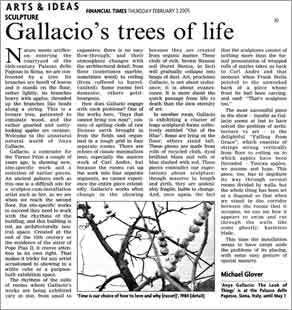
Gallacio's trees of life
By Michael Glover
Nature meets artifice: on entering the courtyard of the 16th-century Palazzo delle Papesse in Siena, we are confronted by a tree. Its branches are bereft of leaves and it stands on the floor, rather lightly, its branches heavy with apples, threaded up the branches like beads along a string. This is a bronze tree, patinated to simulate wood, and the rather gnarled and nutty-looking apples are ceramic. Welcome to the unnatural natural world of Anya Gallacio.
Gallacio, a contender for the Turner Prize a couple of years ago, is showing new, site-specific work and a selection of earlier pieces. An ancient palazzo such as this one is a difficult site for a sculptor-cum-installation artist such as her, as we see when we reach the second floor. For site-specific works to succeed they need to work with the rhythms of the building, and this building is not an architecturally neutral space. Created at the end of the 15th century as the residence of the sister of Pope Pius II, it craves attention in its own right. That makes it tricky for any artist accustomed to showing in a white cube or a purpose-built exhibition space.
The rhythms of the suite of rooms where Gallacio's works are being exhibited vary in size, from small to expansive; there is no easy flow-through; and their atmosphere changes with the architectural detail, from floor (sometimes marble, sometimes wood) to ceiling (from coffered to barrel-vaulted). Some rooms feel domestic, others petit- bourgeois.
How does Gallacio engage with such problems? One of the works here, "Days that cannot bring you near", consists of spilling clods of raw Sienese earth brought in from the fields and organised in a rough grid in four separate rooms. There are echoes of classic minimalism here, especially the austere work of Carl Andre, but because the rooms cut up the work into four separate segments, we cannot experience the entire piece extendedly. Gallacio's works often change in the showing because they are created from organic matter. These clods of rich, brown Sienese soil (burnt Sienna, in fact) will gradually collapse into heaps of dust. Art, proclaims Gallacio, is not about endurance; it is about evanescence. It is more about the quick passage from life to death than the slow eternity of art.
In another room, Gallacio is exhibiting a cluster of huge sculptural forms collectively entitled "Out of the Blue". Some are lying on the floor; others stand tall. These pieces are made from rolls of recycled cloth, dyed brilliant blues and reds or blue slashed with red. These pieces contradict our expectations about sculpture: though massive in length and girth, they are undeniably fragile, liable to change. And, once again, the fact that the sculptures consist of nothing more than the formal presentation of wrapped rolls of matter takes us back to Carl Andre and that moment when Frank Stella pointed to the unworked back of a piece whose front he had been carving, and said: "That's sculpture too."
The most successful piece in the show - insofar as Gallacio seems at last to have solved the problem of architecture vs art - is the delightful "Falling from Grace", which consists of strings strung vertically from floor to ceiling on to which apples have been threaded - Tuscan apples, we assume and hope. This piece, too, has to negotiate its way through several rooms divided by walls, but the whole thing has been set at a diagonal so that when we stand in the corridor between the rooms that it occupies, we can see how it appears to swim and cut through the walls like some ghostly, harmless blade.
This time the installation seems to have swept aside the problems of its placing, with some easy gesture of spatial mastery.
'Anya Gallacio: The Look of Things' is at the Palazzo delle Papesse, Siena, Italy, until May 1
